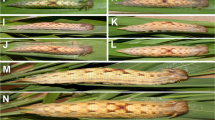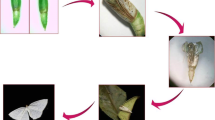Summary
In 1985 and 1986, more than 180 adults of Prodoxus y-inversus Riley eclosed from cocoons of the 1969 generation in Yucca baccata, after prepupal larvae spent 16 and 17 years in diapause, intervals prior to mass emergence that are unmatched by any other insect on record. The emergences, which occurred during 15- to 16-day periods, followed many years of virtually no maturation by other individuals of the colony, and the size of the moths was not diminished by the long wait. Successful delay of development and synchronous emergence by many individuals indicates that whole populations can postpone activities through long periods of conditions that would be adverse for adult activity.
Similar content being viewed by others
References
Amen RD (1963) The concept of seed dormancy. Am Sci 51:408–424
Crocker W (1938) Life-span of seeds. Bot Rev 4:235–274
Crowson RA (1981) The Biology of the Coleoptera. Academic Press, London
Davis DR (1967) A revision of the moths of the subfamily Prodoxinae (Lepidoptera: Incurvariidae). U S Natl Mus Bull 255:1–170
Duffy EAJ (1952) Monograph of Immature Stages of British and Imported Timber Beetles (Cerambycidae). Brit Mus, London
Ferris GF (1919) A remarkable case of longevity in insects (Hem., Hom.). Entomol News 30:27–28
Hedlin AF, Miller GE, Ruth DS (1982) Induction of prolonged diapause in Barbara colfaxiana (Lepidoptera: Oletheutidae): correlations with cone crops and weather. Canad Entomol 116:465–472
Howard LO (1942) Ageing of insects. In: Problems of Ageing. EV Cowdry, ed. Belliere, Tindall & Cox, London:49–65
Linsley EG (1943) Delayed emergence of Buprestis aurulenta from structural timbers. J Econ Entomol 36:348
Maier CT (1980) A mole's-eye view of seventeen-year periodical cicada nymphs, Magicicada septendecim (Hemiptera: Homoptera: Cicadidae). Ann Entomol Soc Am 73:147–152
Miller WE (1977) Wing measure as a size index in Lepidoptera: The family Olethreutidae. Ann Entomol Soc Am 70:253–256
Powell JA (1974) Occurrence of prolonged diapause in ethmiid moths (Lepidoptera: Gelechioidea). Pan-Pacific Entomol 50:220–225
Powell JA (1984) Prolonged diapause in yucca moths. Proc XVII Int Congr Entomol. Abstr vol: 307
Powell JA (1985) Biological interrelationships of moths and Yucca schottii. U Calif Publ Entomol 100:1–93
Powell JA (1987) Records of prolonged diapause in Lepidoptera. J Research Lepid 25:83–109
Powell JA, Mackie RA (1966) Biological interrelationships of moths and Yucca whipplei. U Calif Publ Entomol 42:1–59
Sunose T (1978) Studies on extended diapause in Hasegawaia sasacola Monzen (Diptera: Cecidomyiidae) and its parasites. Kontyu 46:400–415
Sunose T (1983) Prolonged diapause in insects and its ecological significance. Kotaigun Seitai Gakkai Kaikô 37:35–48
Tauber MJ, Tauber CA, Masaki S (1986) Seasonal Adaptations of Insects. Oxford U Press, Oxford and New York, p XV, 411
Ushatinskaya R (1984) A critical review of the superdiapause in insects. Ann Zool 21:3–30
White J, Lloyd M (1975) Growth rates of 17- and 13-year periodical cicadas. Am Midl Nat 94:127–143
Author information
Authors and Affiliations
Rights and permissions
About this article
Cite this article
Powell, J.A. Synchronized, mass-emergences of a yucca moth, Prodoxus Y-inversus (Lepidoptera: Prodoxidae), after 16 and 17 years in diapause. Oecologia 81, 490–493 (1989). https://doi.org/10.1007/BF00378957
Received:
Accepted:
Issue Date:
DOI: https://doi.org/10.1007/BF00378957




